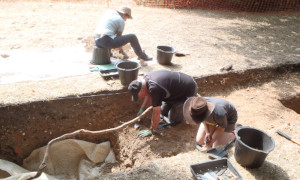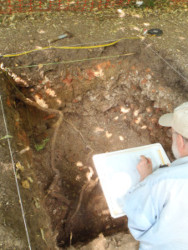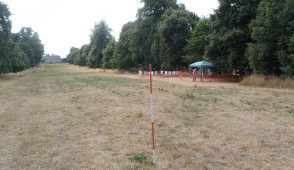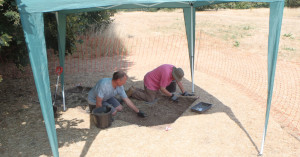20 Jul 2022
Summer Dig - Day 9

We returned to the lime tree avenue of Forty Hall today, having taken two days off to shelter from the record-breaking heatwave that has swept northern Europe.
We picked up where we left off on Sunday, continuing to excavate the rubble rich deposit which fills the cut of what we think may be the moat fronting the inner gatehouse of Elsyng Palace, separating the outer and inner courts.

Having successfully found the eastern side of the 'moat' cut in trench 1 on Sunday, today we resumed the removal of the metre-plus thick deposit of rubble filling it.
This was slow-going today, since the surface of this deposit has been baking in 40-plus degree sunshine for two days and is very hard. Once we've broken through the baked crust of this context hopefully it should become easier going.
Trench 3, meanwhile, located to the west, did not show the far side of the 'moat' cut, as we had hoped, and today we reached the safe limit of depth for excavation. We therefore began drawing and recording this trench today and tomorrow will probably start to backfill it.

One problem that the discovery of the very large rubble-filled 'moat' cut has raised, is how such a moat and any associated gatehouse would join up to the known position of the nearby north range of the palace's outer courtyard.
The location of the north range is one of the few elements of Elsyng that is relatively easy to locate on the ground, at least where its footprint crosses the middle of the lime tree avenue, because in dry summers it leaves clear parch marks in the grass.
These marks are caused by ex-wall lines that were robbed-out in c.1656 and have left the ground slightly more permeable than their surroundings, meaning they retain moisture for slightly longer and so the grass stays slightly greener.

These marks are not as clear closer to the avenue's tree line, however, and the range of buildings they represent clearly do not extend as far as the area we've been excavating so far, within and west of the tree line.
In order to find out just how far this range of buildings comes across the avenue, and also potentially whether the 'moat' cut extends out to meet it, we opened trench 4 today, a small trench located across what should be the inside edge of the north range, just before it meets the row of trees on the western side of the lime avenue.
Having excavated parts of the north range before, we know we shouldn't need to dig very deep to find signs of it, if it is there, and having closed trench 3 we should hopefully have enough time and person-power to get the job done by Sunday.